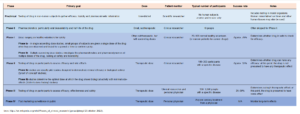Q&A: Fasering van klinische proeven
Op Wikipedia wordt met een overzichtelijke tabel op beknopte wijze de fasering van klinische proeven uitgelegd. Met behulp van deze informatie heb ik een iets fraaiere weergave van de tabel gemaakt.
Klik op de afbeelding voor een grotere weergave.
| Phase | Primary goal | Dose | Patient monitor | Typical number of participants | Success rate[2] | Notes |
|---|---|---|---|---|---|---|
| Preclinical | Testing of drug in non-human subjects to gather efficacy, toxicity and pharmacokinetic information | Unrestricted | Scientific researcher | No human subjects, in vitro and in vivo only | Includes testing in model organisms. Human immortalized cell lines and other human tissues may also be used. | |
| Phase 0 |
Pharmacokinetics; particularly oral bioavailability and half-life of the drug | Small, subtherapeutic | Clinical researcher | 10 people | Often skipped for Phase I. | |
| Phase I |
Dose-ranging on healthy volunteers for safety | Often subtherapeutic, but with ascending doses | Clinical researcher | 20–100 normal healthy volunteers (or cancer patients for cancer drugs) | Approx. 70% | Determines whether drug is safe to check for efficacy. |
|
||||||
| Phase II |
Testing of drug on participants to assess efficacy and side effects | Therapeutic dose | Clinical researcher | 100–300 participants with a specific disease | Approx. 33% | Determines whether drug can have any efficacy; at this point, the drug is not presumed to have any therapeutic effect |
|
||||||
| Phase III |
Testing of drug on participants to assess efficacy, effectiveness and safety | Therapeutic dose | Clinical researcher and personal physician | 300–3,000 people with a specific disease | 25–30% | Determines a drug’s therapeutic effect; at this point, the drug is presumed to have some effect |
| Phase IV |
Post marketing surveillance in public | Therapeutic dose | Personal physician | Anyone seeking treatment from a physician | N/A | Monitor long-term effects |
bron: https://en.wikipedia.org/wiki/Phases_of_clinical_research (geraadpleegd 23 oktober 2022).

